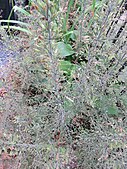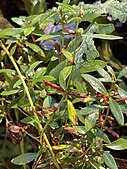-
Larvae of Monostegia abdominalis
-
Leaves skeletonized by larvae
-
Example of red axillary bulblets, observed in late September
| Lysimachia terrestris | |
|---|---|

| |
|
Scientific classification
| |
| Kingdom: | Plantae |
| Clade: | Tracheophytes |
| Clade: | Angiosperms |
| Clade: | Eudicots |
| Clade: | Asterids |
| Order: | Ericales |
| Family: | Primulaceae |
| Genus: | Lysimachia |
| Species: | L. terrestris
|
| Binomial name | |
| Lysimachia terrestris | |
| Synonyms [1] | |
| |
Lysimachia terrestris (swamp candles, lake loosestrife [2] or earth loosestrife) is a plant [3] in the family Primulaceae.
Description
Lysimachia terrestris is a herbaceous plant with opposite, simple leaves, and erect stems. The flowers are produced in a raceme, 10–30 cm (4–12 in) long, at the top of the plant. [4] The flowers are star-shaped with five yellow petals, and appear in mid-summer. Each petal has two red dots at its base forming a circle of ten red dots in the center of the flower. Late in the summer, reddish bulblets form in the leaf axils. They resemble caterpillars and may be mistaken for fruit.
Ecology and distribution
Lysimachia terrestris grows in swamps and at the edges of ponds and lakes in the Eastern United States and in Eastern Canada. It is also found in the U.S. states of Oregon, Washington, and Idaho, and in British Columbia. [4] It is listed as endangered in Tennessee and Kentucky.
A major pest is Monostegia abdominalis, a sawfly whose larvae can completely skeletonize the leaves.
References
- ^ "Lysimachia terrestris". The Plant List: a Working List of All Plant Species. Retrieved 25 June 2015.
- ^ BSBI List 2007 (xls). Botanical Society of Britain and Ireland. Archived from the original (xls) on 2015-06-26. Retrieved 2014-10-17.
- ^ Harry C. Lund (1999). Michigan Wildflowers in Color. Holt, MI: Thunder Bay Press. ISBN 978-1-88237-656-8.
- ^ a b Cholewa, Anita F. (2009). "Lysimachia terrestris". In Flora of North America Editorial Committee (ed.). Flora of North America North of Mexico (FNA). Vol. 8. New York and Oxford: Oxford University Press. Retrieved 8 August 2021 – via eFloras.org, Missouri Botanical Garden, St. Louis, MO & Harvard University Herbaria, Cambridge, MA.
External links
-
 Media related to
Lysimachia terrestris at Wikimedia Commons
Media related to
Lysimachia terrestris at Wikimedia Commons - Lady Bird Johnson Wildflower Center−NPIN: Lysimachia terrestris
- Reznicek, A. A.; Voss, E. G.; Walters, B. S. (February 2011). "Lysimachia terrestris (L.) Britton, Sterns & Poggenb.". Michigan Flora Online. University of Michigan. Retrieved 9 August 2021.
- "Lysimachia terrestris (L.) B.S.P.". Go Botany. Native Plant Trust. Retrieved 9 August 2021.
- "Swamp Candles". Illinois Wildflowers. Retrieved 11 August 2021.


